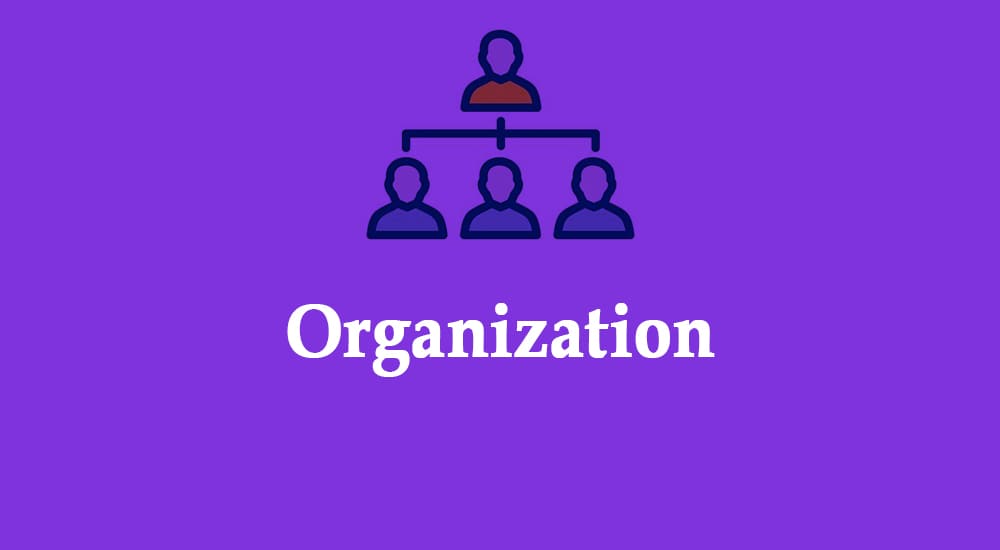
organization
In a world marked by structure and order, the concept of organization plays a pivotal role in shaping our daily lives. Whether it’s within the framework of a business, a community, or even our own thoughts, the term “organization” carries multifaceted meanings and implications.
Defining Organization
How do you define organization? At its core, organization is the arrangement of elements or components into a structured and purposeful whole. It’s the art of coordinating disparate parts to function seamlessly, producing a unified and efficient outcome.
What is organization in your own words? In simple terms, organization is the methodical arrangement of entities, be it people, ideas, or objects, with the intention of achieving specific goals. It involves creating order from chaos, providing clarity and direction in various aspects of life.
Unveiling the Basics
What is organizing in simple words? Organizing, in its simplest form, is the process of arranging elements systematically to achieve a desired result. It’s the step-by-step approach to structure, categorize, and streamline resources, ensuring optimal utilization and effectiveness.
Why is it called organization? The term “organization” finds its roots in the Latin word “organum,” meaning an instrument or tool. This etymology reflects the idea that an organization functions as a tool, harmonizing diverse components to produce a collective impact greater than the sum of its parts.
Defining Characteristics
What is the definition of organization and examples? An organization can be defined as a group of individuals or entities working together in a structured manner to achieve common objectives. Examples range from corporate entities and non-profit organizations to social clubs and even the intricate workings of the human body.
What is organization and its characteristics? Organization is characterized by key features such as structure, purpose, and collaboration. The structured arrangement of elements, a defined purpose or mission, and collaboration among members are fundamental aspects that distinguish a well-functioning organization.
The Essence of Organization: Decoding Its Significance
The Crucial Role of Organization in Our Lives
Organization isn’t merely a concept confined to the corporate realm; it’s an integral part of our daily existence. From the structure of our homes to the flow of traffic on city streets, the principles of organization shape the functionality of our surroundings.
Streamlining Complexity Through Structure
In essence, organization acts as a powerful tool for simplifying complexity. By categorizing, arranging, and establishing hierarchies, we create systems that make sense, allowing us to navigate through the intricacies of life with relative ease.
Exploring the Layers: Different Facets of Organization
1. Organizational Structures: The Backbone of Efficiency
In the business world, organizational structures are the blueprints that define how activities are coordinated and controlled. Whether it’s a hierarchical model, matrix structure, or a network-based setup, each has its unique advantages, influencing how information flows and decisions are made.
2. The Social Fabric: Organizations Beyond the Workplace
Beyond the corporate landscape, organizations take various forms, shaping the social fabric of communities and societies. Clubs, associations, and non-profits are prime examples, demonstrating how people come together, driven by shared interests or goals.
Why Does Organization Matter?
Creating Order from Chaos
Imagine a scenario without organization – chaos would ensue. Whether it’s a business struggling to meet objectives or a community lacking structure, the absence of organization can lead to inefficiency, confusion, and a failure to achieve collective goals.
Enhancing Productivity and Efficiency
On the flip side, a well-organized entity is poised for success. Efficiency improves, resources are utilized optimally, and individuals within the organization find clarity in their roles and responsibilities.
Organization in Practice: Real-world Examples and Case Studies
Examining Successful Organizational Models
1. Corporate Giants: Lessons from Industry Leaders
Explore the organizational structures of renowned companies like Google, Apple, and Amazon. These industry leaders showcase diverse approaches to organization, emphasizing innovation, collaboration, and adaptability as key components of their success.
2. Non-Profit Marvels: Achieving Impact through Structure
Delve into the organizational strategies of impactful non-profit organizations. Whether focused on environmental conservation, healthcare, or education, these entities demonstrate how effective organization amplifies their capacity to make a positive difference.
Case Studies: Learning from Organizational Challenges
1. Crisis Management: The Importance of Agile Organization
Examine instances where organizations faced unexpected challenges. From economic downturns to global crises, discover how adaptable organizational structures and strategic planning contributed to resilience and recovery.
2. Startups and Flexibility: Navigating the Unknown
Startups often operate in dynamic environments. Explore how these organizations leverage flexible structures and adaptive strategies to thrive in uncertain conditions, offering valuable insights for businesses of all scales.
The Anatomy of Successful Organizations: Key Characteristics
1. Clear Mission and Vision
Successful organizations articulate a clear mission and vision. This foundational element provides a sense of purpose, guiding decision-making and unifying members toward common objectives. Whether a business, community group, or nonprofit, a defined mission is the compass that directs the organization’s journey.
2. Effective Communication Channels
Communication is the lifeblood of any organization. Establishing effective channels for internal and external communication fosters transparency, collaboration, and a sense of belonging among members. From regular team meetings to comprehensive reporting structures, communication fuels the engine of organizational success.
3. Adaptability and Flexibility
In a rapidly changing world, adaptability is a hallmark of successful organizations. Whether responding to market shifts, technological advancements, or unexpected challenges, organizations that embrace change and adjust their strategies accordingly are better positioned for long-term success.
4. Strong Leadership
Leadership is a linchpin in organizational effectiveness. Successful organizations are led by individuals who inspire, guide, and foster a positive organizational culture. Leadership isn’t solely about authority but also about cultivating a shared vision and empowering others to contribute their best.
5. Employee Engagement and Well-being
The well-being and engagement of employees significantly impact organizational performance. Successful organizations prioritize creating a positive work environment, offering opportunities for professional growth, and recognizing the contributions of their team members.
6. Embracing Diversity and Inclusion
Diversity is a strength that fuels innovation and creativity. Successful organizations recognize the value of diverse perspectives and actively promote inclusivity. This fosters a culture where individuals feel valued, leading to increased collaboration and a richer organizational tapestry.
Conclusion: Navigating the Landscape of Organization
In conclusion, organization is the backbone of success in various realms of life. From the intricacies of corporate structures to the collaborative spirit of social organizations, the principles of organization shape the world around us.
By understanding the essence of organization, learning from real-world examples, and embracing key characteristics, individuals and entities can navigate the dynamic landscape of today’s challenges and opportunities.






